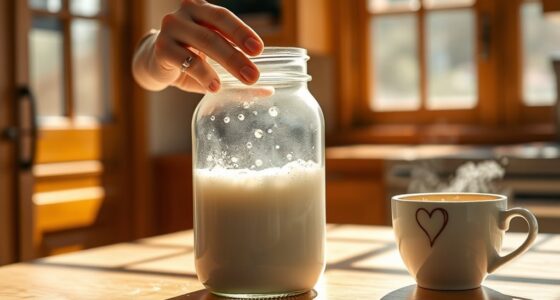During roasting, heat breaks down trigonelline into compounds that serve as aroma precursors, enhancing coffee’s flavor complexity. As temperature rises, trigonelline transforms into smaller molecules like pyridines and pyrroles, which develop into volatile aroma compounds such as pyrazines and furans. These chemistry changes create layered, rich aromas and deepen flavor profiles. Continuing explores how mastering these reactions allows you to craft ideal roasts with vibrant, desirable tastes and aromas.
Key Takeaways
- During roasting, trigonelline decomposes into smaller compounds that serve as aroma precursors.
- Heat accelerates trigonelline’s breakdown, leading to the formation of pyridines, pyrroles, and other volatile aroma compounds.
- The transformation pathway depends on roasting temperature and duration, influencing aroma development.
- Degraded trigonelline contributes to Maillard reaction products, enhancing roasted and aromatic notes.
- Proper roasting controls optimize trigonelline’s conversion, resulting in desirable aroma precursor formation and flavor complexity.
The Role of Trigonelline in Seeds and Grains

Trigonelline plays a significant role in seeds and grains by acting as a natural defense compound. In seed chemistry, this alkaloid helps protect against pests and diseases, ensuring seed viability. When examining grain composition, you’ll notice trigonelline is concentrated in the outer layers, serving as a chemical shield. Its presence influences how seeds respond during processing, particularly in roasting. Understanding its role in seed chemistry offers insights into how grains naturally defend themselves and maintain quality. Trigonelline’s stability in raw seeds makes it a key component in the chemical makeup of grains, contributing to their resilience. Recognizing its function helps you appreciate how seed chemistry and grain composition work together to preserve seed integrity and influence flavor development during roasting. Additionally, recent studies in AI data analysis have helped identify how chemical compounds like trigonelline change during thermal processes, providing deeper insights into flavor precursors.
The Impact of Heat on Chemical Reactions During Roasting

When you roast, heat triggers chemical reactions that change the flavor and color of your food. The Maillard reaction starts, creating complex aromas and browning the surface, while caramelization develops sweetness. These processes alter the chemical makeup, influencing both taste and nutritional properties. Furthermore, understanding these chemical reactions can help optimize roasting techniques for better flavor development.
Maillard Reaction Initiation
Heat plays a crucial role in initiating the Maillard reaction during roasting, setting the stage for complex chemical changes that develop flavor and aroma. As temperatures rise, amino acids and sugars undergo Maillard chemistry, forming new compounds that contribute to the unique sensory qualities of roasted coffee. This reaction begins subtly but accelerates quickly, creating a foundation for flavor enhancement. The process involves the condensation of amino groups with reducing sugars, producing melanoidins and other molecules responsible for the rich, roasted notes. By controlling heat, you influence the extent and progression of Maillard chemistry, shaping the depth and complexity of the final flavor profile. Understanding this initiation phase helps you optimize roasting conditions to maximize aroma precursors and achieve desired sensory qualities. Additionally, monitoring thermal dynamics during roasting ensures precise control over chemical reactions, leading to consistent and high-quality flavor development.
Caramelization Processes Occur
As temperatures climb during roasting, caramelization processes kick into gear, transforming sugars into complex, flavorful compounds. You’ll notice sugar caramelization occurring as heat causes sugars to break down and form new molecules, contributing rich, sweet aromas. This process is vital for developing the deep, roasted flavors you associate with coffee. The formation of aroma compounds results from these chemical changes, adding layers of scent and taste. As the heat intensifies, caramelization accelerates, producing a variety of volatile compounds that enhance the coffee’s overall sensory profile. Understanding this process helps you appreciate how heat transforms simple sugars into an array of complex, appealing flavors, enriching the aroma and taste characteristics of roasted coffee. Natural materials play a significant role in influencing the chemical reactions during roasting, further shaping the development of aroma precursors.
Chemical Composition Changes
During roasting, chemical reactions rapidly alter the composition of coffee beans, transforming their flavor, aroma, and color. This chemical transformation involves breaking down complex compounds and forming new ones, which leads to flavor enhancement. As heat intensifies, sugars caramelize, acids degrade, and Maillard reactions occur, creating a variety of aromatic molecules. Trigonelline breaks down into pyridines and other compounds that contribute to aroma, while chlorogenic acids diminish, affecting both taste and stability. These changes are vital for developing the coffee’s characteristic profile. You’ll notice the evolution of flavor as the beans roast, driven by these chemical transformations. Ultimately, heat acts as a catalyst, shaping the complex, layered flavors that define freshly brewed coffee.
Conversion of Trigonelline Into Aroma Precursors

Conversion of trigonelline into aroma precursors is a crucial step during roasting, as it influences the development of flavor and aroma in the final product. When roasting, trigonelline breaks down into compounds that develop aroma precursors, shaping the flavor profile. The pathways of this degradation are influenced by roasting temperature and duration, affecting the quality of the aroma. Understanding these processes helps you optimize conditions to enhance desirable flavors in your product. Additionally, the sustainability of roasting practices impacts the overall quality and environmental footprint of the process.
Trigonelline Degradation Pathways
Have you ever wondered how trigonelline transforms into aroma precursors during processing? Trigonelline degradation is a key step in forming aroma precursors, involving chemical changes that produce compounds responsible for flavor development. When exposed to heat, trigonelline breaks down into smaller molecules, such as pyridines and pyrroles, which serve as aroma precursors. These pathways facilitate the formation of volatile compounds that contribute to the aroma profile of roasted coffee or other products. The degradation process is influenced by temperature and time, accelerating the formation of desirable aroma compounds. Understanding these pathways helps you see how roasting transforms trigonelline into the complex aroma precursors that define the sensory qualities of coffee and other roasted foods. Sound design techniques can be used to enhance the sensory experience of aroma development in sensory analysis or product presentation.
Impact of Roasting Conditions
Roasting conditions play a significant role in determining how trigonelline converts into aroma precursors. Temperature effects and time control directly influence the chemical pathways involved. Higher temperatures accelerate the breakdown of trigonelline, forming key aroma compounds more rapidly, but can also lead to undesirable degradation if not managed carefully. Precise timing ensures ideal precursor formation without over-roasting. Consider the following table:
| Temperature Range | Duration | Effect on Trigonelline Conversion |
|---|---|---|
| 150°C – 170°C | 10-15 minutes | Moderate precursor formation |
| 170°C – 190°C | 15-20 minutes | Increased aroma precursor development |
| 190°C – 210°C | 20-25 minutes | Rapid conversion, risk of over-roasting |
| 210°C – 230°C | 25-30 minutes | Potential for burnt flavors, precursors degrade |
| 230°C and above | 30+ minutes | Uncontrolled reactions, undesirable outcomes |
Adjusting these parameters is key to crafting desirable aroma profiles.
Key Compounds Formed in the Roasting Process

During the roasting process, a variety of key compounds form that considerably influence the flavor, aroma, and overall quality of coffee. These compounds include Maillard reaction products, which contribute to flavor complexity by creating a range of taste notes. Pyrazines develop early, adding vegetal and roasted aromas, while furans and aldehydes enrich the aroma profile with sweet, caramel-like scents. Melanoidins, formed in later stages, enhance body and contribute to aroma enhancement. Additionally, volatile compounds such as pyrazines, ketones, and esters develop during roasting, intensifying aroma layers. Together, these compounds shape the distinctive sensory characteristics of coffee, making each roast unique. Recognizing these key compounds helps you understand how roasting’s chemical transformations drive flavor depth and aroma richness. Moreover, understanding the AI Security considerations involved in developing advanced roasting and sensory analysis technologies can help ensure the reliability and safety of these innovations.
How These Compounds Influence Flavor and Aroma

The compounds formed in the roasting process directly influence the coffee’s flavor and aroma, shaping your sensory experience with each sip. These molecules contribute to flavor complexity, adding layers of taste from fruity to nutty notes. They also play a key role in aroma enhancement, releasing volatile compounds that make your coffee smell inviting and rich. As roasting progresses, these compounds develop and interact, creating a balance between sweetness, acidity, and bitterness. The aroma precursors, like transformed trigonelline and other Maillard reaction products, add depth and vibrancy to the aroma profile. Understanding how these compounds influence flavor and aroma enhances appreciation of the intricate chemistry behind a cup’s sensory appeal. This knowledge highlights the importance of precise roasting for achieving your desired coffee experience.
The Art and Science Behind Optimizing Roasting for Flavor Development

Achieving the ideal flavor profile hinges on a delicate balance between science and artistry, requiring roasters to carefully control heat, time, and airflow. You’ll need to focus on flavor balancing, ensuring that each variable complements the others to develop desirable aromas and tastes. Sensory analysis becomes your guide, helping you detect subtle changes in aroma, acidity, and body throughout the roast. By adjusting parameters based on these observations, you optimize the transformation of compounds like trigonelline into aroma precursors. Mastering this process involves understanding the chemistry behind roasting and honing your palate. Additionally, utilizing security features such as password strength indicators and session management tools ensures safe and reliable operation of your roasting data systems. When done correctly, this blend of science and skill results in a complex, harmonious flavor profile that highlights the unique qualities of each batch.
Frequently Asked Questions
How Does Trigonelline Content Vary Among Different Seed Varieties?
You’ll notice that seed variety markedly influences trigonelline levels. Different types, like Arabica or Robusta coffee beans, naturally contain varying amounts of this compound. Some varieties have higher trigonelline content, which can affect flavor and aroma development during roasting. Understanding these differences helps you select seeds with desired characteristics, ensuring ideal aroma precursors and overall quality in your brewing process.
What Factors Influence the Rate of Chemical Reactions During Roasting?
You should understand that reaction kinetics and heat transfer mainly influence how quickly chemical reactions occur during roasting. Higher temperatures accelerate reaction rates, while efficient heat transfer guarantees uniform heating. Factors like roasting time, temperature control, and the seed’s moisture content also play roles. By managing these elements, you can control reaction speed, affecting flavor development and aroma precursor formation, making your roasting process more precise and consistent.
Can Roasting Parameters Be Customized for Specific Aroma Profiles?
You can definitely customize roasting parameters to achieve specific aroma profiles. By adjusting temperature, time, and airflow, you optimize the roasting process for desired flavor characteristics. This roasting parameter optimization allows you to tailor aroma profile customization, enhancing certain volatile compounds while suppressing others. Experimenting with these variables helps you develop unique, consistent flavors that match your target profiles, giving you control over your coffee’s final aroma and taste.
Are There Health Implications Linked to Trigonelline Transformation?
Think of your health as a delicate garden, where every choice impacts growth. When you consider trigonelline transformation, know that roasting can alter health risks and dietary benefits. While moderate roasting may enhance antioxidants, excessive heat might produce harmful compounds. You should weigh these factors, as proper roasting optimizes benefits and minimizes health risks, helping you enjoy coffee’s flavors without compromising your well-being.
How Do Storage Conditions Affect the Stability of Aroma Precursors?
You should consider how storage conditions impact your coffee’s aroma precursors. Poor storage stability, like exposure to moisture, heat, or light, can cause aroma loss and diminish flavor quality. To preserve aroma, keep your beans in airtight containers, in a cool, dark place, and avoid temperature fluctuations. Proper storage guarantees aroma preservation, maintaining fresh, vibrant flavors and the overall quality of your coffee over time.
Conclusion
Think of roasting as a symphony where heat transforms humble trigonelline into a rich aroma masterpiece. By understanding this delicate dance, you can perfect your craft, revealing deeper flavors and enticing aromas in every cup or bite. Embrace the science behind the transformation, and let each roast be a harmonious act of alchemy. Ultimately, mastering this process turns ordinary ingredients into extraordinary sensory experiences you’ll savor with every sip or bite.









